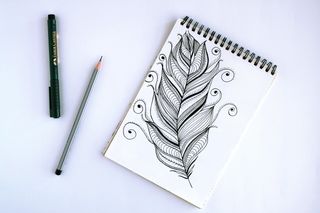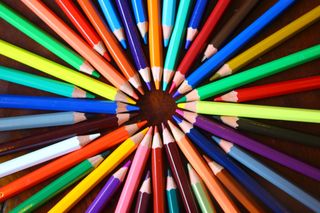Coloring for Well-Being: Evidence and Applications
- Living reference work entry
- First Online: 11 November 2023
- Cite this living reference work entry

- Nicola J. Holt 3
15 Accesses
3 Altmetric
Doodling ; Drawing ; Mindfulness coloring ; Painting-by-numbers ; Visual art
Coloring is using color (through various art materials, including colored pencils, felt-tip pens, pastels, watercolors, etc.), to fill the blank spaces in a line drawing or design.

Introduction
Adults are increasingly using coloring as a tool to reduce stress and anxiety and to enhance mindful attention. A rise in the popularity of coloring has been reflected in the production and sales of coloring books, downloadable coloring pages, and coloring apps (Vanry, 2019 ), as well as the use of coloring to reduce anxiety in applied settings, such as cancer wards, patient waiting rooms, care homes, university libraries, and primary schools (e.g., Blackburn & Chamley, 2016 ; Rigby & Taubert, 2016 ). While evidence for the role of the visual arts in general has burgeoned, suggesting multiple health and well-being benefits (Fancourt & Finn, 2019 ), coloring research is relatively nascent, with studies...
This is a preview of subscription content, log in via an institution to check access.
Access this chapter
Institutional subscriptions
Active Minds. (2018). https://www.active-minds.org/uk/dementia-art-activities/coloring-books/ . Accessed 3 June 2019.
Alzheimer’s Society. (2018). Five online activity ideas for people living with dementia. https://www.alzheimers.org.uk/blog/5-online-activity-ideas-people-living-dementia . Accessed 3 June 2019.
BBC. (2020). Color your own thank you to NHS staff. https://www.bbc.co.uk/programmes/articles/MxHKChgvM08r1fS410jqV/color-your-own-thank-you-to-nhs-staff . Accessed 24 June 2020.
Blackburn, H., & Chamley, C. (2016). Color me calm: Adult coloring and the University library. In Criss Library Faculty Proceedings & Presentations , 78. https://digitalcommons.unomaha.edu/crisslibfacproc/78
Bryce, J., & Haworth, J. (2002). Wellbeing and flow in sample of male and female office workers. Leisure Studies, 21 (3–4), 249–263. https://doi.org/10.1080/0261436021000030687
Article Google Scholar
Bühnemann, G. (2017). Modern mandala meditation: Some observations. Contemporary Buddhism, 18 (2), 263–276.
Burton, B. N., & Baxter, M. F. (2019). The effects of the leisure activity of coloring on post-test anxiety in graduate level occupational therapy students. The Open Journal of Occupational Therapy, 7 (1). https://doi.org/10.15453/2168-6408.1451
Campenni, C. E., & Hartman, A. (2020). The effects of completing mandalas on mood, anxiety, and state mindfulness. Art Therapy, 37 (1), 25–33. https://doi.org/10.1080/07421656.2019.1669980
Carsley, D., & Heath, N. L. (2018). Effectiveness of mindfulness-based coloring for test anxiety in adolescents. School Psychology International, 39 (3), 251–272.
Carsley, D., & Heath, N. L. (2019a). Evaluating the effectiveness of a mindfulness coloring activity for test anxiety in children. The Journal of Educational Research, 112 (2), 143–151. https://doi.org/10.1080/00220671.2018.1448749
Carsley, D., & Heath, N. L. (2019b). Effectiveness of mindfulness-based coloring for university students’ test anxiety. Journal of American College Health, 68 (5), 518–527. https://doi.org/10.1080/07448481.2019.1583239
Cohen, B. E., Edmondson, D., & Kronish, I. M. (2015). State of the art review: Depression, stress, anxiety, and cardiovascular disease. American Journal of Hypertension, 28 (11), 1295–1302.
Creswell, J. D. (2017). Mindfulness interventions. Annual Review of Psychology, 68 , 491–516. https://doi.org/10.1146/annurev-psych-042716-051139
Cross, G., & Brown, P. M. (2019). A comparison of the positive effects of structured and nonstructured art activities. Art Therapy, 36 (1), 22–29. https://doi.org/10.1080/07421656.2019.1564642
Crozier, J. C., Van Voorhees, E. E., Hooper, S. R., & De Bellis, M. D. (2011). Effects of abuse and neglect on brain development. In C. Jenny (Ed.), Child abuse and neglect: Diagnosis, treatment and evidence (pp. 516–525). Elsevier Saunders.
Chapter Google Scholar
Curry, N. A., & Kasser, T. (2005). Can coloring mandalas reduce anxiety? Art Therapy, 22 (2), 81–85. https://doi.org/10.1080/07421656.2005.10129441
Czerwinski, N., Egan, H., Cook, A., & Mantzios, M. (2020). Teachers and mindful coloring to tackle burnout and increase mindfulness, resiliency and wellbeing. Contemporary School Psychology . https://doi.org/10.1007/s40688-020-00279-9
Drake, C. R., Searight, H. R., & Olson-Pupek, K. (2014). The influence of art-making on negative mood states in university students. American Journal of Applied Psychology, 2 (3), 69–72. https://doi.org/10.12691/ajap-2-3-3
Drake, J. E., Hastedt, I., & James, C. (2016). Drawing to distract: Examining the psychological benefits of drawing over time. Psychology of Aesthetics, Creativity, and the Arts, 10 (3), 325–331. https://doi.org/10.1037/aca0000064
Dresler, E., & Perera, P. (2019). Doing mindful coloring: Just a leisure activity or something more? Leisure Studies, 38 (6), 862–874. https://doi.org/10.1080/02614367.2019.1583765
Duong, K., Stargell, N. A., & Mauk, G. W. (2018). Effectiveness of coloring mandala designs to reduce anxiety in graduate counseling students. Journal of Creativity in Mental Health, 13 (3), 318–330. https://doi.org/10.1080/15401383.2018.1437001
Eastwood, J. D., Frischen, A., Fenske, M. J., & Smilek, D. (2012). The unengaged mind: Defining boredom in terms of attention. Perspectives on Psychological Science, 7 (5), 482–495. https://doi.org/10.1177/1745691612456044
Eaton, J., & Tieber, C. (2017). The effects of coloring on anxiety, mood, and perseverance. Art Therapy, 34 (1), 42–46. https://doi.org/10.1080/07421656.2016.1277113
Fancourt, D., & Finn, S. (2019). What is the evidence on the role of the arts in improving health and well-being? A scoping review (Health Evidence Network (HEN) synthesis report 67). WHO Regional Office for Europe.
Google Scholar
Flett, J. A., Lie, C., Riordan, B. C., Thompson, L. M., Conner, T. S., & Hayne, H. (2017). Sharpen your pencils: Preliminary evidence that adult coloring reduces depressive symptoms and anxiety. Creativity Research Journal, 29 (4), 409–416. https://doi.org/10.1080/10400419.2017.1376505
Forkosh, J., & Drake, J. E. (2017). Coloring versus drawing: Effects of cognitive demand on mood repair, flow, and enjoyment. Art Therapy, 34 (2), 75–82. https://doi.org/10.1080/07421656.2017.1327272
Fortier, M. A., Del, A. R., Martin, S. R., & Kain, Z. N. (2010). Perioperative anxiety in children. Paediatric Anaesthesia, 20 (4), 318–322.
Fredrickson, B. L. (2004). Positive emotions broaden and build. Philosophical Transactions of the Royal Society, 359 , 1367–1377. https://doi.org/10.1098/rstb.2004.1512
Henderson, P., Rosen, D., & Mascaro, N. (2007). Empirical study on the healing nature of mandalas. Psychology of Aesthetics, Creativity, and the Arts, 1 (3), 148–154. https://doi.org/10.1037/1931-3896.1.3.148
Holt, N. J., Furbert, L., & Sweetingham, E. (2019). Cognitive and affective benefits of coloring: Two randomized controlled crossover studies. Art Therapy, 36 (4), 200–208. https://doi.org/10.1080/07421656.2019.1645498
I support the NHS. (2020). I support the NHS. https://www.isupportthenhs.co.uk/ . Accessed 24 June 2020.
Jorm, A. F., Christensen, H., Griffiths, K. M., Parslow, R. A., Rodgers, B., & Blewitt, K. A. (2004). Effectiveness of complementary and self-help treatments for anxiety disorders. Medical Journal of Australia, 181 , S29–S46. https://doi.org/10.5694/j.1326-5377.2004.tb06352.x
Kaimal, G., Mensinger, J., Drass, J., & Dieterich-Hartwell, R. (2017). Art therapist-facilitated open studio versus coloring: Differences in outcomes of affect, stress, creative agency, and self-efficacy. Canadian Art Therapy Association Journal, 30 (2), 56–68. https://doi.org/10.1080/08322473.2017.1375827
Kaimal, G., Ayaz, H., Herres, J., Dieterich-Hartwell, R., Makwana, B., Kaiser, D. H., & Nasser, J. A. (2018). Functional near-infrared spectroscopy assessment of reward perception based on visual self-expression: Coloring, doodling, and free drawing. The Arts in Psychotherapy, 55 , 85–92.
Konnopka, A., & König, H. (2020). Economic burden of anxiety disorders: A systematic review and meta-analysis. PharmacoEconomics, 38 , 25–37. https://doi.org/10.1007/s40273-019-00849-7
Koo, M., Chen, H. P., & Yeh, Y. C. (2020). Coloring activities for anxiety reduction and mood improvement in Taiwanese community-dwelling older adults: A randomized controlled study. Evidence-Based Complementary and Alternative Medicine . https://doi.org/10.1155/2020/6964737
Lampitt, A. K. (2018). Understanding why women knit: Finding creativity and “flow”. Textile, 16 (1), 84–97.
Lee, S. (2018). Why color mandalas? A study of anxiety-reducing mechanisms. Art Therapy, 35 (1), 35–41. https://doi.org/10.1080/07421656.2018.1459105
Lindsay, E. K., & Creswell, J. D. (2017). Mechanisms of mindfulness training: Monitor and Acceptance Theory (MAT). Clinical Psychology Review, 51 , 48–59. https://doi.org/10.1016/j.cpr.2016.10.011
Maguire, P., Coughlan, A., Drayton, D., Lacko, H., Reich, J., & Hatfield, L. (2020). The effect of coloring mandalas on the anxiety of medical-surgical nurses and nursing support staff. Medsurg Nursing, 29 (3), 192–199.
Malchiodi, C. (2019). Expressive arts therapy as self-regulatory and relational interventions with children and caregivers. In J. Mitchell, J. Tucci, & E. Tronick (Eds.), The handbook of therapeutic care for children: Evidence-informed approaches to working with traumatized children and adolescents in foster, kinship and adoptive care (pp. 289–309). Jessica Kingsley.
Mantzios, M., & Giannou, K. (2018). When did coloring books become mindful? Exploring the effectiveness of a novel method of mindfulness-guided instructions for coloring books to increase mindfulness and decrease anxiety. Frontiers in Psychology, 9 , 56. https://doi.org/10.3389/fpsyg.2018.00056
Nakamura, J., & Csikszentmihalyi, M. (2014). The concept of flow. In M. Csikszentmihalyi (Ed.), Flow and the foundations of positive psychology (pp. 239–263). Springer.
Norris, C. J., Creem, D., Hendler, R., & Kober, H. (2018). Brief mindfulness meditation improves attention in novices: Evidence from ERPs and moderation by neuroticism. Frontiers in Human Neuroscience, 12 , 315. https://doi.org/10.3389/fnhum.2018.00315
Pereira-Lima, K., & Loureiro, S. R. (2015). Burnout, anxiety, depression, and social skills in medical residents. Psychology, Health & Medicine, 20 (3), 353–362. https://doi.org/10.1080/13548506.2014.936889
Powell, A., Alcorn, K., & Lindsay, K. (2017). Effect of coloring on student stress levels. American Journal of Recreation Therapy, 16 (1), 9–16. https://doi.org/10.5055/ajrt.2017.0122
Rajendran, N., Mitra, T. P., Shahrestani, S., & Coggins, A. (2020). Randomized controlled trial of adult therapeutic coloring for the management of significant anxiety in the emergency department. Academic Emergency Medicine, 27 (2), 92–99. https://doi.org/10.1111/acem.13838
Remes, O., Brayne, C., Van Der Linde, R., & Lafortune, L. (2016). A systematic review of reviews on the prevalence of anxiety disorders in adult populations. Brain and Behavior, 6 (7), e00497. https://doi.org/10.1002/brb3.497
Rigby, M., & Taubert, M. (2016). Coloring books for adults on the cancer ward. British Medical Journal, 352 , h6795.
Robinson, E. M., Baker, R., & Hossain, M. M. (2018). Randomized trial evaluating the effectiveness of coloring on decreasing anxiety among parents in a pediatric surgical waiting area. Journal of Pediatric Nursing, 41 , 80–83. https://doi.org/10.1016/j.pedn.2018.02.001
Rodak, J., Alloway, T. P., & Rizzo, M. (2018). PTSD’s true color: Examining the effect of coloring on anxiety, stress, and working memory in veterans. Mental Health & Prevention, 12 , 50–54. https://doi.org/10.1016/j.mhp.2018.09.007
Routledge, C., Wildschut, T., Sedikides, C., & Juhl, J. (2013). Nostalgia as a resource for psychological health and well-being. Social and Personality Psychology Compass, 7 (11), 808–818. https://doi.org/10.1111/spc3.12070
Salazar, L. R. (2019). Exploring the effect of coloring mandalas on students’ math anxiety in business statistics courses. Business, Management and Education, 17 (2), 134–151.
Sandmire, D. A., Rankin, N. S., Gorham, S. R., Eggleston, D. T., French, C. A., Lodge, E. E., Kuns, G. C., & Grimm, D. R. (2016). Psychological and autonomic effects of art making in college-aged students. Anxiety, Stress, & Coping, 29 (5), 561–569. https://doi.org/10.1080/10615806.2015.1076798
Sheldon, K. M., Prentice, M., & Halusic, M. (2015). The experiential incompatibility of mindfulness and flow absorption. Social Psychological and Personality Science, 6 (3), 276–283.
Sloan, D. M., & Marx, B. P. (2004). A closer examination of the structured written disclosure procedure. Journal of Consulting and Clinical Psychology, 72 (2), 165–175. https://doi.org/10.1037/0022-006X.72.2.165
Turturro, N., & Drake, J. E. (2020). Does coloring reduce anxiety? Comparing the psychological and psychophysiological benefits of coloring versus drawing. Empirical Studies of the Arts . https://doi.org/10.1177/0276237420923290
van der Vennet, R., & Serice, S. (2012). Can coloring mandalas reduce anxiety? A replication study. Art Therapy, 29 (2), 87–92. https://doi.org/10.1080/07421656.2012.680047
Vanry, N. (2019). Adult coloring books trend. https://bookriot.com/adult-coloring-books-trend/ . Accessed 24 June 2020.
Download references
Author information
Authors and affiliations.
University of the West of England, Bristol, UK
Nicola J. Holt
You can also search for this author in PubMed Google Scholar
Corresponding author
Correspondence to Nicola J. Holt .
Editor information
Editors and affiliations.
School of Health Sciences, The University of Nottingham, Nottingham, UK
Paul Crawford
Queen Margaret University, Edinburgh, UK
Paul Kadetz

Section Editor information
University of Surrey, Guildford, UK
Victoria Tischler
Rights and permissions
Reprints and permissions
Copyright information
© 2024 The Author(s), under exclusive licence to Springer Nature Switzerland AG
About this entry
Cite this entry.
Holt, N.J. (2024). Coloring for Well-Being: Evidence and Applications. In: Crawford, P., Kadetz, P. (eds) Palgrave Encyclopedia of the Health Humanities. Palgrave Macmillan, Cham. https://doi.org/10.1007/978-3-030-26825-1_17-1
Download citation
DOI : https://doi.org/10.1007/978-3-030-26825-1_17-1
Received : 04 January 2022
Accepted : 05 October 2023
Published : 11 November 2023
Publisher Name : Palgrave Macmillan, Cham
Print ISBN : 978-3-030-26825-1
Online ISBN : 978-3-030-26825-1
eBook Packages : Springer Reference Literature, Cultural and Media Studies Reference Module Humanities and Social Sciences Reference Module Humanities
- Publish with us
Policies and ethics
- Find a journal
- Track your research

Are Adult Coloring Books Actually Helpful?
Exploring the mental health benefits of the coloring book trend..
Posted March 27, 2018 | Reviewed by Jessica Schrader
- What Is Anxiety?
- Take our Generalized Anxiety Disorder Test
- Find a therapist to overcome anxiety
Within the last decade adult coloring books have surged in popularity. The vast selection available today includes abstract images, mandalas, and your beloved characters ranging from Marvel to Disney , and anything in between (like famous Facebook kitty, Pusheen ). If you prefer, you can shift the scenery as you explore a secret garden , lost ocean , or perhaps an enchanted forest . Themes aside, these activity books have often been best sellers and claim to provide users with the opportunity to connect with their inner artists, reduce stress , and live happier lives.
But do they?

I’ve heard friends, family, students, and clients all share their personal pleasant experiences with adult coloring books. And honestly, I truly enjoy my own. I recognize that just because my personal interpretation tends to be echoed in those around me, that doesn’t mean that an illustration a day keeps the woes away. Yet noticing this widespread phenomenon caused me to consider that coloring could indeed be broadly therapeutic.
But what is so appealing?
- Is it the nostalgia for the free coloring we experienced as children?
- Perhaps it gives us a creative outlet to break our rigid routines?
- Or could it be the mindfulness achieved as we disconnect from chaos and connecting to the present?
Previous studies have provided support for adult coloring books. Curry and Kasser induced anxiety in a group of undergraduates, provided them either with a blank page, a plaid print, or a mandala, and instructed them to color for 20 minutes. Both designs reduced anxiety, although the mandala was slightly more effective. However, in a replication study by van der Vennet and Serice , no difference was observed between for those who had plaid and blank pages, yet the mandala group still displayed a reduction in anxiety.
In a recent study, Mantzios and Giannou utilized randomized controlled experiments to explore the differences between coloring and free-drawing. In one experiment there were no differences in between an unguided coloring group and free-drawing. However, in the second experiment participants were assigned to either a guided or unguided mandala coloring group, and although no differences were noted in mindfulness, those in the guided group did show a reduction in anxiety.
Researchers at the International Islamic University Islamabad delved further into the potential to reduce anxiety. In a quasi-experimental study it was found that the use of mandalas was able to decrease both state anxiety (i.e. contextual emotional experience) and trait anxiety (i.e. personality characteristic) in just 30 minutes, however, the difference in state anxiety was almost twice that of the difference noted in trait anxiety.

Adult coloring books have been shown to influence more than anxiety. Researchers at the University of Otago randomly assigned participants to a coloring a logic-puzzle group and found that after a week of daily practice displayed significantly lower levels of anxiety and depressive symptoms. In a study of individuals ages 19-67 participants engaged in coloring independently and in an open studio environment with an art therapist. Both scenarios helped participants to reduce stress and negative affect, however, the session with the art therapist prompted significant enhancements of personal perceptions pertaining to creativity , self-efficacy , and positive effect.
It seems as though adult coloring books are therapeutic , but they aren’t therapy .
There may be benefits to improving mood, enhancing mindfulness, and reducing mental health stress, but the personal process may be distinct from the growth one encounters in therapy. If you do enjoy this artistic activity and hope to improve your mental health, perhaps you may benefit from seeking a creative practitioner or an art therapist to help you along your journey.

Shainna Ali, Ph.D. , is a practitioner, educator, and advocate who is passionate about highlighting the essentiality of mental health in fostering happiness and fulfillment.
- Find a Therapist
- Find a Treatment Center
- Find a Psychiatrist
- Find a Support Group
- Find Online Therapy
- United States
- Brooklyn, NY
- Chicago, IL
- Houston, TX
- Los Angeles, CA
- New York, NY
- Portland, OR
- San Diego, CA
- San Francisco, CA
- Seattle, WA
- Washington, DC
- Asperger's
- Bipolar Disorder
- Chronic Pain
- Eating Disorders
- Passive Aggression
- Personality
- Goal Setting
- Positive Psychology
- Stopping Smoking
- Low Sexual Desire
- Relationships
- Child Development
- Self Tests NEW
- Therapy Center
- Diagnosis Dictionary
- Types of Therapy

When we fall prey to perfectionism, we think we’re honorably aspiring to be our very best, but often we’re really just setting ourselves up for failure, as perfection is impossible and its pursuit inevitably backfires.
- Emotional Intelligence
- Gaslighting
- Affective Forecasting
- Neuroscience

IMAGES
VIDEO